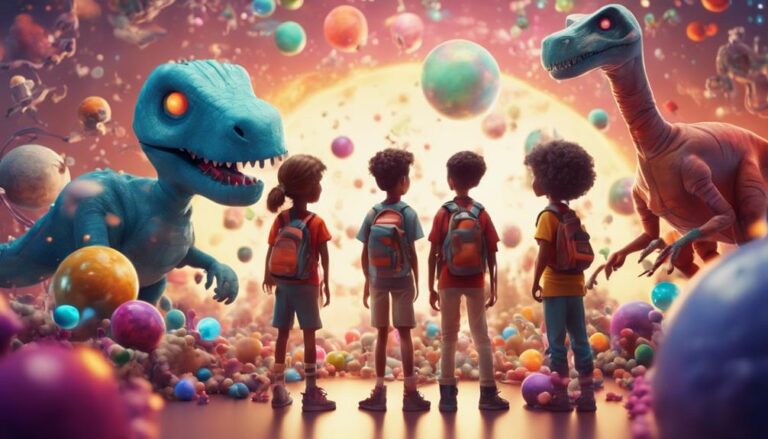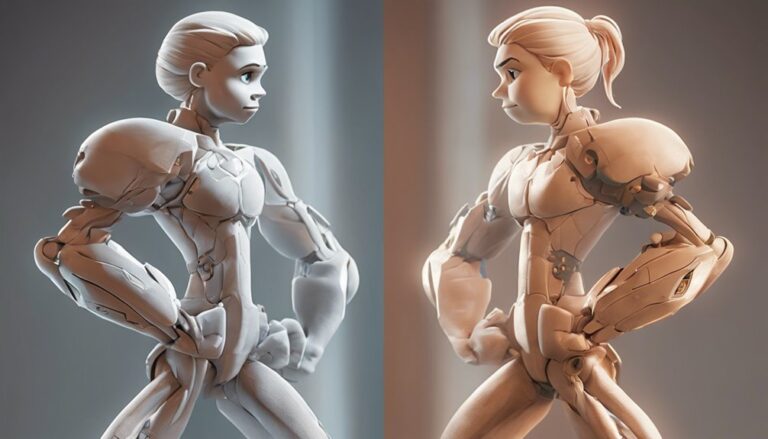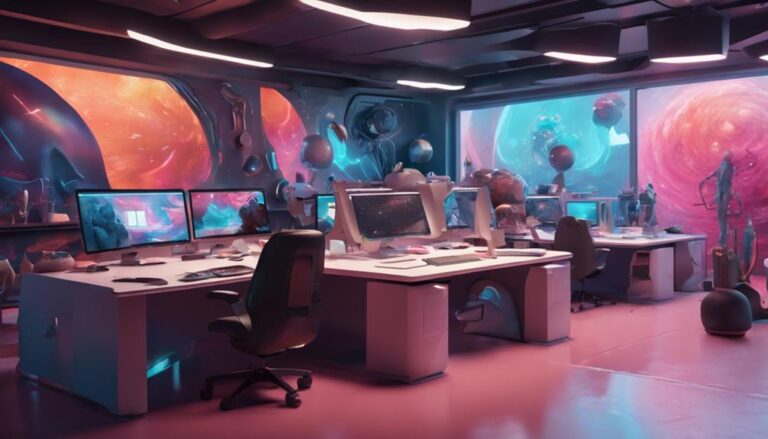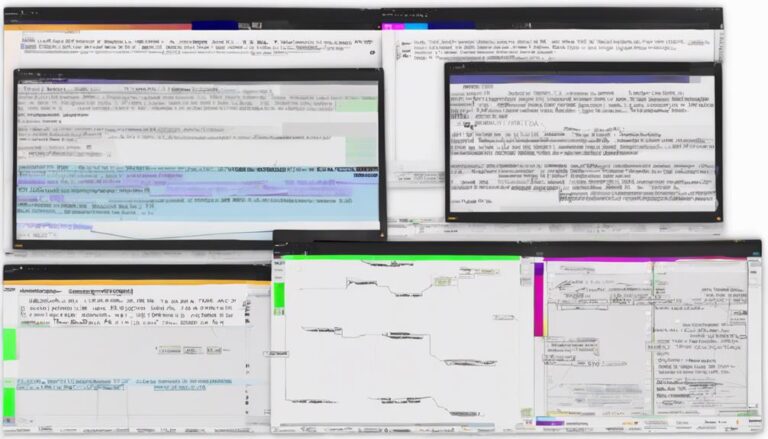Finishing Touches: Stop Motion Post-Production Essentials
To master the finishing touches of your stop motion project, refine your post-production skills in color correction, sound design, editing, and visual effects. Achieve aesthetic consistency in your color palette with deliberate color correction techniques, and elevate emotional impact with effective sound design and strategic Foley techniques. Use editing software to adjust timing and pacing, and incorporate visual effects tools like motion blur and particle simulation to add depth and realism. Next, explore the power of compositing and motion graphics to enhance your visual storytelling and transport your audience to a captivating world of wonder.
Key Takeaways
- Color grading techniques, including LUTs and color wheels, maintain aesthetic consistency throughout the film.
- Effective sound design and audio mixing create an immersive experience, balancing sound levels and music placement.
- Editing sets the rhythmic heartbeat of the narrative, with pacing adjustments made through timing and shot length manipulation.
- Visual effects and compositing tools enhance stop motion films, adding depth and realism through motion blur and particle simulation.
- Motion graphics integration and final rendering polish the film, with careful attention to layer management and frame manipulation.
Color Correction Techniques
Most stop motion productions require a certain aesthetic consistency in their color palette, which is often achieved through deliberate color correction techniques in post-production.
As you begin color correcting your stop motion production, start by referencing your color script, which outlines the intended color grading for each scene. This script serves as a guide for maintaining visual cohesion throughout the film.
When it comes to color grading, you'll need to balance the overall color palette, making adjustments to brightness, contrast, and saturation as needed.
This process can be time-consuming, but it's essential for achieving the desired mood and atmosphere in your film. Use color wheels and hue vs. saturation curves to identify and adjust problematic colors.
Additionally, consider using LUTs (look-up tables) to apply a consistent color grade across multiple scenes.
Sound Design Fundamentals
Effective sound design in stop motion productions can elevate the emotional impact and immersive quality of your film.
You'll want to focus on creating a rich sonic landscape that complements your visuals and engages your audience. To do this, start by understanding the basics of sound waves. Sound waves are vibrations that travel through the air, and they can be manipulated in various ways to create different effects.
For example, you can use reverb to create a sense of space or distortion to add texture.
When it comes to stop motion, Foley techniques are essential for creating realistic sound effects.
Foley involves creating and recording sounds that match the action on screen, such as footsteps, rustling fabric, or clinking objects. You can use everyday objects to create unique sounds, like using a metal colander to create the sound of rain or a trash bag to create the sound of a bird flapping its wings.
Editing for Pacing
Editing for Pacing
Your stop motion film's pacing is the rhythmic heartbeat that drives the narrative forward, and editing is the crucial process that sets this rhythm in motion. As you begin editing, refer back to your storyboard and make any necessary refinements to ensure your pacing aligns with your original vision. Storyboard refinement at this stage can help you identify areas where your pacing may be off and make targeted adjustments.
Timing adjustments are also crucial in editing for pacing. Experiment with different lengths for each scene and shot to find the perfect rhythm. Here are some general guidelines to consider:
| Scene Type | Recommended Length |
|---|---|
| Action sequence | 10-30 seconds |
| Dialogue scene | 30-60 seconds |
| Emotional moment | 60-90 seconds |
Visual Effects Tools
With your stop motion film's pacing in check, you can now focus on enhancing its visual elements.
This is where visual effects tools come in, allowing you to add an extra layer of depth and realism to your animation. One essential tool is motion blur, which simulates the blur that occurs when objects move quickly. This can be achieved through software such as Adobe After Effects or Nuke, where you can apply motion blur to specific elements or the entire frame.
Another key tool is particle simulation, which enables you to create realistic effects like fire, smoke, or water.
Software like Houdini or Blender can be used to create complex simulations that interact with your stop motion elements. When working with particle simulation, it's essential to balance realism with artistic control, ensuring that the effects enhance your animation without overpowering it.
Compositing Stop Motion
Compositing stop motion involves layering multiple elements to create a cohesive, visually stunning final image.
You'll need to manage multiple layers of imagery, including characters, backgrounds, and special effects. Effective layer management is crucial to maintaining a clear and organized compositing workflow.
This involves naming and organizing layers in a logical manner, using folders and groups to keep related elements together.
As you composite, you'll also need to manipulate frames to achieve the desired visual effect.
This might involve adjusting the timing and spacing of frames to create a sense of movement or energy.
You can also use frame manipulation to enhance the performance of your characters, making them appear more lifelike and engaging.
Audio Mixing Essentials
When you start mixing the audio for your stop motion project, balancing sound levels is crucial to create a cohesive and immersive experience.
You'll need to carefully adjust the levels of dialogue, sound effects, and music to ensure that each element complements the others without overpowering them.
Effective music placement also plays a key role, as strategically placing score cues can heighten emotional impact, emphasize key moments, and guide the viewer's attention.
Balancing Sound Levels
Tackling audio post-production head-on, you'll find that balancing sound levels is crucial to creating an immersive experience for your stop motion film.
To achieve this balance, you'll need to master the art of volume riding – the manual adjustment of audio levels in real-time. This technique allows you to fine-tune your sound levels, ensuring that dialogue, sound effects, and background noise are all well-balanced and easy to hear.
When working with multiple audio tracks, audio ducking is another essential technique to employ.
This process involves automatically reducing the volume of one audio track when another track is playing. For example, you can use audio ducking to lower the volume of background music when dialogue is present, ensuring that the dialogue remains clear and audible.
Effective Music Placement
Your stop motion film's soundtrack is more than just a collection of songs – it's a sonic tapestry that weaves together to evoke emotions and enhance the viewing experience.
When it comes to effective music placement, you'll want to consider the tone, mood, and pacing of each scene. This involves carefully selecting tracks that complement the action on screen and don't overpower the dialogue or sound effects.
Music licensing is crucial in post-production, as using copyrighted music without permission can lead to costly lawsuits.
Research licensing options and ensure you have the necessary rights to use your chosen tracks. Consider the cultural relevance of the music, too, as certain genres or styles may resonate more with your target audience.
To effectively place music in your stop motion film, experiment with different tracks and timings. Pay attention to how the music interacts with the visuals and sound design.
Use music to elevate key moments, create tension, or evoke emotions. By carefully crafting your soundtrack, you'll create a rich and immersive experience for your audience.
Effective music placement is a delicate balance, but with practice and patience, you can create a sonic tapestry that elevates your stop motion film to new heights.
Final Cut Editing
Final Cut editing is the culmination of your stop motion post-production efforts, where you meticulously weave together the threads of sound, image, and narrative to create a cohesive whole.
At this stage, you've already assembled your rough cut, and now it's time to refine your editorial vision. This involves carefully balancing the pacing, tone, and emotional resonance of your film.
Considering the creative constraints of your project, such as time, budget, and technical limitations, you'll need to make deliberate decisions about what to include, what to cut, and how to shape the narrative arc.
As you work through the editing process, keep your overall vision in mind, but also remain open to new ideas and possibilities.
Experiment with different editing styles, techniques, and rhythms to enhance the emotional impact of your film. Pay close attention to the relationship between sound and image, ensuring that they work together seamlessly to create a unified whole.
Motion Graphics Integration
Incorporating motion graphics into your stop motion film elevates the visual storytelling, adding an extra layer of depth and emotion to the narrative.
You can seamlessly integrate motion graphics into your stop motion footage using video editing software like Adobe After Effects or Premiere Pro.
Start by identifying the areas where graphic elements can enhance the storytelling, such as title sequences, transitions, or explanatory graphics.
To integrate motion graphics, you'll need to export your edited stop motion footage as a final composite.
Then, import this footage into your chosen motion graphics software.
Use keyframe animation to create dynamic movements and interactions between graphic elements and your stop motion characters.
Animated typography can also be used to emphasize important dialogue or themes, adding an extra layer of visual interest to your film.
When designing your motion graphics, consider the style and tone of your stop motion film.
Ensure that the graphic elements are consistent with the overall aesthetic and don't overwhelm the stop motion footage.
Visual Storytelling Tips
To elevate your stop motion narrative, you'll want to focus on crafting an emotional connection with your audience through strategic color choices, manipulating pacing for maximum visual impact, and creating a clear visual hierarchy that guides the viewer's eye through each scene.
By applying these techniques, you'll be able to amplify the emotional resonance of your story and engage your audience on a deeper level.
Emotional Connection Through Color
Crafting an emotional connection through color is pivotal in stop motion post-production, as it enables you to evoke a specific response from your audience.
To achieve this, it's essential to develop a color strategy that complements your narrative.
Start by creating a color script, which outlines the color palette for each scene.
This will help you visualize how colors will interact and evoke emotions throughout your story.
Color Palette Considerations:
- Establish a dominant color: Choose a key color that reflects the mood or atmosphere of your scene, and use it consistently throughout to create a sense of continuity.
- Balance warm and cool colors: Use warm colors (orange, red) to create a sense of energy, and cool colors (blue, green) to evoke calmness or serenity.
- Create contrast with neutrals: Use neutral colors (black, white, gray) to create contrast and make your dominant color stand out.
Develop a mood board to visualize your color palette and ensure it aligns with your narrative goals.
Pacing for Visual Impact
Pacing for Visual Impact
By expertly controlling the pacing of your stop motion animation, you create opportunities to heighten emotional impact, deepen character connections, and elevate the overall narrative.
Pacing is crucial in guiding the viewer's emotional journey, and in stop motion, it's achieved through the manipulation of frame rate, shot duration, and scene transitions.
To create a cohesive visual flow, you must balance quick cuts with slower, more deliberate sequences, mirroring the emotional beats of your story.
When cutting between scenes, consider the emotional resonance you want to convey.
A cut that occurs on a strong action or emotional peak can amplify the impact, while a cut that occurs during a lull can create a sense of disconnection.
By varying the length and timing of your shots, you can build tension, release, and create moments of introspection.
This deliberate pacing will keep your audience engaged, invested in the characters, and responsive to the emotional beats of the narrative.
Effective pacing is key to crafting a compelling story that lingers long after the final frame.
Creating a Visual Hierarchy
Effective pacing lays the groundwork for a captivating narrative, but it's the visual composition that elevates your stop motion animation into a truly immersive experience.
A well-crafted visual hierarchy is essential in guiding your audience's attention through the scene. By controlling the visual flow, you can create a clear narrative and evoke emotions in your viewers.
To achieve this, focus on establishing clear focal points in your scene.
These focal points should draw the viewer's attention and create a sense of visual interest.
Here are three key considerations for creating an effective visual hierarchy:
- Contrast: Use contrasting colors, textures, and lighting to create visual interest and draw attention to specific elements in the scene.
- Size and scale: Use size and scale to create a sense of hierarchy, with larger elements taking precedence over smaller ones.
- Placement: Strategically place elements in the scene to create a clear visual flow and guide the viewer's attention through the narrative.
Final Rendering Process
Your final rendered output is the culmination of all the work you've put into your stop motion project.
This stage is crucial, as it determines the quality and compatibility of your final product. When setting up your render, consider the intended use of your video.
Are you exporting for web, film, or television? Different mediums require unique render settings to ensure optimal playback quality.
You'll need to select the right file format for your project. Popular options include H.264, ProRes, and QuickTime.
Consider the file size, codec, and resolution requirements for your chosen format. For web-based projects, H.264 is a suitable choice, as it offers a balance between quality and compression.
If you're working with a high-end client or exporting for film, ProRes or QuickTime may be more suitable due to their higher quality and flexibility.
When setting your render settings, pay attention to resolution, frame rate, and color depth.
Ensure that these settings match your project's requirements to avoid unnecessary upscaling or downscaling.
Additionally, consider the bit depth and chroma subsampling settings to maintain the highest possible image quality.
Frequently Asked Questions
How Do I Protect My Project From Data Loss and Corruption?
You protect your project by implementing a robust Data Backup strategy, syncing files to an external drive and Cloud Syncing services, like Google Drive or Dropbox, to ensure automatic, real-time backups and minimize data loss risks.
What Is the Ideal Storage for Stop Motion Project Files?
You'll want ideal storage for your files, so consider Cloud Storage for accessibility and External Drives for security, allowing you to safeguard your project files and access them whenever needed, no matter the location.
Can I Work on Post-Production Remotely With My Team?
You can work on post-production remotely with your team by using cloud collaboration tools and virtual meetings to review projects, share feedback, and track progress in real-time, enhancing remote teamwork and productivity.
How Do I Deliver My Stop Motion Project to Clients?
You'll deliver your stop motion project to clients by meeting their expectations for final files, providing master copies in suitable formats like ProRes or H.264, and following specified delivery methods, such as cloud uploads or hard drives.
Are There Any Industry Standards for File Organization and Naming?
When managing files, you establish a Folder Hierarchy, organizing assets logically for easy access. You also use Naming Conventions, standardizing file titles with version numbers, dates, and descriptive keywords to streamline collaboration and workflow efficiency.
Conclusion
You've reached the final stage of your stop motion project. As you wrap up post-production, remember that every detail counts. Verify your color correction is polished, sound design is balanced, and pacing is on point. Ensure seamless compositing, precise motion graphics integration, and effective visual storytelling. With your final cut edited and visual effects in place, proceed to the rendering process, double-checking that all elements are perfectly in sync. Export with confidence.







